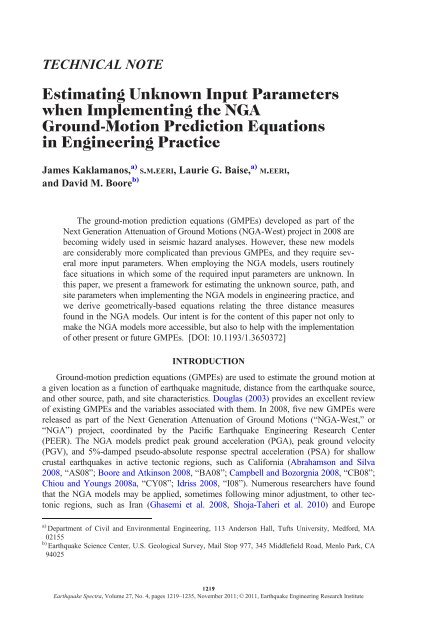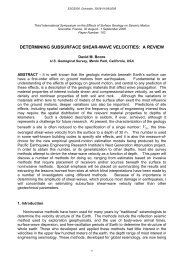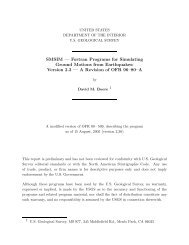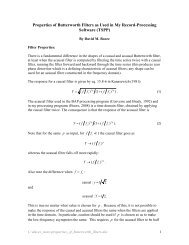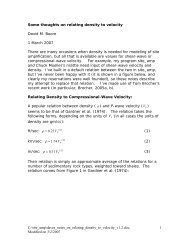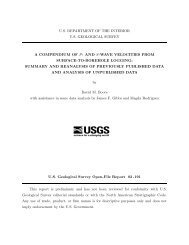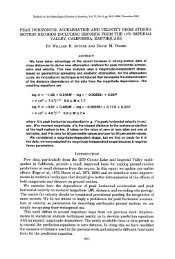388 Kb - David M. Boore
388 Kb - David M. Boore
388 Kb - David M. Boore
You also want an ePaper? Increase the reach of your titles
YUMPU automatically turns print PDFs into web optimized ePapers that Google loves.
TECHNICAL NOTEEstimating Unknown Input Parameterswhen Implementing the NGAGround-Motion Prediction Equationsin Engineering PracticeJames Kaklamanos, a) S.M.EERI, Laurie G. Baise, a) M.EERI,and <strong>David</strong> M. <strong>Boore</strong> b)The ground-motion prediction equations (GMPEs) developed as part of theNext Generation Attenuation of Ground Motions (NGA-West) project in 2008 arebecoming widely used in seismic hazard analyses. However, these new modelsare considerably more complicated than previous GMPEs, and they require severalmore input parameters. When employing the NGA models, users routinelyface situations in which some of the required input parameters are unknown. Inthis paper, we present a framework for estimating the unknown source, path, andsite parameters when implementing the NGA models in engineering practice, andwe derive geometrically-based equations relating the three distance measuresfound in the NGA models. Our intent is for the content of this paper not only tomake the NGA models more accessible, but also to help with the implementationof other present or future GMPEs. [DOI: 10.1193/1.3650372]INTRODUCTIONGround-motion prediction equations (GMPEs) are used to estimate the ground motion ata given location as a function of earthquake magnitude, distance from the earthquake source,and other source, path, and site characteristics. Douglas (2003) provides an excellent reviewof existing GMPEs and the variables associated with them. In 2008, five new GMPEs werereleased as part of the Next Generation Attenuation of Ground Motions (“NGA-West,” or“NGA”) project, coordinated by the Pacific Earthquake Engineering Research Center(PEER). The NGA models predict peak ground acceleration (PGA), peak ground velocity(PGV), and 5%-damped pseudo-absolute response spectral acceleration (PSA) for shallowcrustal earthquakes in active tectonic regions, such as California (Abrahamson and Silva2008, “AS08”; <strong>Boore</strong> and Atkinson 2008, “BA08”; Campbell and Bozorgnia 2008, “CB08”;Chiou and Youngs 2008a, “CY08”;Idriss 2008, “I08”). Numerous researchers have foundthat the NGA models may be applied, sometimes following minor adjustment, to other tectonicregions, such as Iran (Ghasemi et al. 2008, Shoja-Taheri et al. 2010) and Europea) Department of Civil and Environmental Engineering, 113 Anderson Hall, Tufts University, Medford, MA02155b) Earthquake Science Center, U.S. Geological Survey, Mail Stop 977, 345 Middlefield Road, Menlo Park, CA940251219Earthquake Spectra, Volume 27, No. 4, pages 1219–1235, November 2011; VC 2011, Earthquake Engineering Research Institute
1220J. KAKLAMANOS, L. G. BAISE, AND D. M. BOORETable 1. Input parameters of the NGA models (modified from Kaklamanos and Baise 2011)ModelParameter AS08 BA08 CB08 CY08 I08Source parameters:Moment magnitude, M Depth-to-top of rupture, Z TOR Down-dip rupture width, WFault dip, d Style-of-faulting flag (function of rake angle, k) Aftershock flag (for models applicable to aftershocks) Path parameters:Closest distance to the rupture plane (rupture distance), R RUPHorizontal distance to the surface projection of the rupture (Joyner-<strong>Boore</strong> distance), R JBHorizontal distance to top edge of rupture measured perpendicular to the strike (site coordinate), R XHanging-wall flag Site parameters:Time-averaged shear-wave velocity over the top 30 meters of the subsurface, V S30Depth to V S ¼ 1.0 km/s (Z 1.0 ) Depth to V S ¼ 2.5 km/s (Z 2.5 ) PGA (or PSA) on rock, as baseline for nonlinear site response (Campbell and Bozorgnia 2006, Scasserra et al. 2009, Stafford et al. 2008). Thus, theseGMPEs are beginning to have an impact on seismic hazard analyses worldwide.Although the new NGA models have significantly higher prediction accuracies thantheir predecessors (as quantified by Kaklamanos and Baise 2011), they are also significantlymore complicated. As seen in Table 1, which displays the input parameters for the fiveNGA models, they vary significantly in terms of complexity and number of predictor variables.Kaklamanos and Baise (2011) find that the more complex NGA models (those withmore input parameters and more complexity of functional forms) do not have a predictiveadvantage over the simpler NGA models in many situations because the values of severalinput parameters are often unknown. When implementing the NGA models, users are facedwith the challenge of estimating unknown input parameters, for some of which there is limitedguidance in the literature. In this paper, we present a clear framework for estimating thesource, path, and site parameters when applying the NGA models. Our framework requiresthe user to specify a bare minimum of five values:• Moment magnitude, M• Joyner-<strong>Boore</strong> distance, R JB• Time-averaged shear-wave velocity over a subsurface depth of 30 meters, V S30
ESTIMATING UNKNOWN INPUT PARAMETERS WHEN IMPLEMENTING THE NGA GMPES 1221• Style of faulting (e.g., rake angle, k)• Hanging-wall flag, F HWThe remaining input parameters may be estimated by the methods described in this paper.It is important to note that by the laws of error propagation, uncertainties in the predictorvariables (source, path, and site) are transmitted to the ground motion estimate. Assumethat x appears as an input parameter in a relationship for estimating y; in a strict sense, if anempirical correlation with standard deviation r x is used to estimate x, then the standarddeviation of y will be represented by r total , modified from r y by:sffiffiffiffiffiffiffiffiffiffiffiffiffiffiffiffiffiffiffiffiffiffiffiffiffiffiffiffiffir total ¼ r 2 y þ @y 2r@x2 x: (1)In GMPEs, for which the total standard deviation is determined in natural logarithmic space,y in the above equation would be ln(PGA), ln(PGV), or ln(PSA). One advantage of havingmore complex GMPEs with many input parameters is lower aleatory variabilities (sigmas),but these lower sigmas are inappropriate if the input parameters are unknown, because theuncertainties of the estimated input parameters will propagate into the uncertainty of theestimated ground motion. For each NGA model, however, the developers incorporated typicaluncertainties of earthquake source, path, and site processes into the estimates of aleatoryvariability. A full analysis and discussion of error propagation is beyond the scope of thistechnical note. Bommer et al. (2005) provide an excellent discussion on the effects of conversionsof predictor variables on the aleatory variability of GMPEs.Kaklamanos et al. (2010) used the framework introduced in this paper for their implementationsof the NGA models in the programming languages Fortran and R (R DevelopmentCore Team 2011). In this paper, we describe the selected methods of estimation in Kaklamanoset al. (2010) and present alternatives to those selected methods. First, we offer recommendationsfor estimating the source characteristics describing the fault rupture plane:the fault dip (d), down-dip rupture width (W), and depth-to-top of rupture (Z TOR ). Secondly,we derive physically based equations that relate the three distance measures usedin the NGA models: (1) the slant distance to the closest point on the rupture plane (therupture distance, R RUP ), (2) the horizontal distance to the surface projection of the rupture(the Joyner-<strong>Boore</strong> distance, R JB ), and (3) the horizontal distance to the surface projectionof the top edge of the rupture measured perpendicular to the fault strike (the site coordinate,R X ). These equations will be useful for situations in which the geometric coordinatesof the fault rupture are not pre-determined, and for checking for consistency between thevarious distance measures. The vertical cross section in Figure 1 illustrates the three distancemeasures and three rupture parameters for a hypothetical site. We also compare ourphysical equations to alternative empirical methods for estimating the distance parameters.Finally, we summarize methods of estimating the site parameters required in additionto V S30 : the soil depth parameters Z 1.0 (depth to V S ¼ 1.0 km/s, used in AS08 and CY08)and Z 2.5 (depth to V S ¼ 2.5 km/s, used in CB08). Our intent is for the content of this paperto make the NGA models more accessible to earthquake engineering practitioners. Additionally,this framework may help with the implementation of other present or futureGMPEs for seismic hazard analyses.
1222J. KAKLAMANOS, L. G. BAISE, AND D. M. BOOREFigure 1. Illustration of earthquake source and distance measures using a vertical cross sectionthrough a fault rupture plane. The length of the fault rupture plane (L) is measured along thestrike (perpendicular to the plane of the page).ESTIMATION OF SOURCE PARAMETERSThe fault dip, down-dip rupture width, and depth-to-top of rupture are often unknown forhistorical earthquakes without finite fault models, and for various earthquake scenarios in seismichazard analyses. Here, we offer recommendations for estimating these rupture parametersfrom the earthquake magnitude and style of faulting. First, however, we provide a clarificationon how the different NGA models classify style of faulting by the rake angle for an event. Asummary of the style-of-faulting classifications for the five NGA models is presented in Table4ofAbrahamson et al. (2008). However, there are some ambiguities when this is comparedto the individual papers, with regards to some inequalities being open or closed. In the implementationof Kaklamanos et al. (2010), these ambiguities were reconciled by following thestyle-of-faulting recommendations in the individual papers (superseding Abrahamson et al.2008, where there is conflicting information), and we present the summary in Table 2 in thispaper. For example, for an event with k ¼ 30 , CB08 differs from the other models in classifyingthe event as strike-slip instead of reverse. If the style of faulting is known but the valueof k is not, the user may assume generic rake angles of 90 for reverse events, 90 for normalevents, 0 for left-lateral strike-slip events, and 180 for right-lateral strike-slip events(although GMPEs make no distinction between left-lateral and right-lateral strike-slip events).FAULT DIP ANGLE, dFor faults with sufficient geologic data and/or previous seismic activity, this supplementalinformation may be used to make a reasonable assumption for the dip angle (d). When d cannotbe specified, it may be estimated from the style of faulting (using the rake angle) with the
ESTIMATING UNKNOWN INPUT PARAMETERS WHEN IMPLEMENTING THE NGA GMPES 1223Table 2. NGA style-of-faulting classificationsRange of rake angles (deg)Model Reverse faulting Normal faulting Strike-slip faultingAS08 30 k 150 120 k 60 180 < k < 120, 60 < k < 30, and 150 < k < 180BA08 30 k 150 150 k 30 180 < k < 150, 30 < k < 30, and 150 < k < 180CB08 30 < k < 150 150 < k < 30 180 k 150, 30 k 30, and 150 k 180CY08 30 k 150 120 k 60 180 < k < 120, 60 < k < 30, and 150 < k < 180I08 30 k 150 N/A 180 < k < 30 and 150 < k < 180following guidelines, modified from the approach given in Chiou and Youngs (2008b). Followingstandard practice, strike-slip faults are assumed to be vertical (d ¼ 90 ). Average valuesare recommended for normal faulting events (d ¼ 50 ) and reverse faulting events (d ¼ 40 ).The recommendation for normal faulting events comes from an analysis of the normal faultingearthquakes in the NGA flatfile and the worldwide compilations by Collettini and Sibson(2001) and Jackson and White (1989), as well as events in the Finite-Source Rupture ModelDatabase (Mai 2007). For reverse faulting earthquakes, Sibson and Xie (1998) find that thefault dip distribution is bimodal, with one peak near 30 and a subsidiary peak near 50 , withan average dip angle in the range of 40 . Our recommendation is consistent with the findingsof Sibson and Xie (1998) and the approach of Chiou and Youngs (2008b), and our recommendeddip angle is close to that of the reverse faulting events in the NGA flatfile (43.5 ).DOWN-DIP RUPTURE WIDTH, WThe down-dip rupture width (W) may be estimated from the moment magnitude and styleof faulting, using the relationships found in Table 2A in Wells and Coppersmith (1994):8< 10 0:76þ0:27M for strike-slip eventsW ¼ 10 1:61þ0:41M for reverse events(2):10 1:14þ0:35M for normal events:Given the size of the regression database and the statistical robustness of the relationships,the Wells and Coppersmith (1994) empirical equations are a reasonable method for estimatingW.DEPTH-TO-TOP OF RUPTURE, Z TORLittle guidance exists in the literature on the estimation of Z TOR . The method employedin Kaklamanos et al. (2010) is to estimate Z TOR from the hypocentral depth (Z HYP ), downdiprupture width (W), and dip (d), assuming that the hypocenter is located 60% down thefault width, as suggested by the results of Mai et al. (2005):Z TOR ¼ max½ðZ HYP 0:6W sin dÞ; 0Š: (3)The values of W and d may be estimated using the aforementioned methods, and Z HYP maybe estimated using the linear relationship between Z HYP and M published in Table 1 ofScherbaum et al. (2004):
1224J. KAKLAMANOS, L. G. BAISE, AND D. M. BOORE8< 5:63 þ 0:68M for strike-slip faultingZ HYP ¼ 11:24 0:2M for non-strike-slip faulting:7:08 þ 0:61M for general ðunspecifiedÞ faulting(4)We assume strike-slip events to have rake angles within 30 of horizontal; the general equationmay be applied for borderline cases. Due to differences in the stress fields leading torupture, dipping faults tend to have ruptures that originate deeper in the earth than strikeslipfaults. For larger-magnitude earthquakes, there is an increase in the amount of energyreleased and the size of the rupture. To accommodate a larger rupture area, hypocenters ofstrike-slip events must become progressively deeper as the magnitude increases. The hypocentraldepths of dip-slip and strike-slip events become more similar as M increases.ESTIMATION OF DISTANCE PARAMETERSUsing various geometric principles, we derive physical equations relating the three distancemeasures required to implement the NGA models. GMPEs developed prior to theNGA project generally included just one type of distance parameter per model, so the issuesof geometrical consistency are not an issue for these models. For models with multiple distanceparameters (AS08, CB08, and CY08), the geometrical interdependence of the distanceparameters is a phenomenon that must be considered in model implementation, especiallyat small distances; otherwise, considerable errors in ground-motion prediction can result.Our equations will be useful for implementing the NGA and other GMPEs in seismic hazardanalyses and in research using historical earthquake datasets (such as the NGA flatfileused for GMPE development), which may not have information on new distance measuressuch as R X . Little has been written in the literature about R X , which is used in the AS08 andCY08 models for quantifying the hanging-wall effect. There is no clear published descriptionon the physical relationship between R X and the other distance parameters. Spudich andChiou (2008) define a generalized geometry for multisegment ruptures, but they do not providean explicit formulation for R X .To derive our distance equations, we must define an important location measure, thesource-to-site azimuth (a). Figure 2 is a plan view of the surface projection of the rupturedarea, and the surface projection of the top edge of rupture, which aligns with the fault strike.The positive y-axis is directed along the fault strike such that the ruptured area is to theright. The positive x-axis is in the direction of the ruptured area (the hanging-wall side ofthe fault). The source-to-site azimuth (a) for a given site is the angle between the positive faultstrike direction and the line connecting the site to the closest point on the surface projection ofthe top edge of rupture, with clockwise angles assumed positive (Chiou 2005). Sites locatedon the hanging wall have positive azimuths (ranging from 0 to 180 ), and sites located on thefootwall have negative azimuths (ranging from 180 to 0 ). R X is defined to be positive forsites on the hanging-wall side of the fault and negative for sites on the footwall side of the fault(Chiou and Youngs 2008a). As Figure 3 illustrates, a site can be categorized into one of ninecases, based (1) on the value of a, and (2) on some additional specifications on how the site isoriented with respect to the ruptured area (for sites on the hanging-wall side of the fault).Our equations are derived by characterizing the earthquake source by the geometric parametersW, Z TOR , and d, and characterizing the location of the site of interest by assuming
ESTIMATING UNKNOWN INPUT PARAMETERS WHEN IMPLEMENTING THE NGA GMPES 1225Figure 2. Plan view of a fault rupture, giving the definition and sign convention of the sourceto-siteazimuth (a). Also illustrated are five example sites and their source-to-site azimuths andsite coordinates. Sites 1, 2, and 4, which are located on the hanging-wall side of the fault, havepositive azimuths and site coordinates; sites 3 and 5, which are located on the footwall side ofthe fault, have negative azimuths and site coordinates.R JB and a. We use the Joyner-<strong>Boore</strong> distance (R JB ) as the primary distance measure becauseit is easily visualized in two dimensions as the horizontal distance to the surface projection ofthe rupture, and it can be thought of as an approximate epicentral distance. Therefore, if theuser has only a generic source-to-site distance (R) for a ground-motion calculation, it is notunreasonable to use R JB as the primary distance upon which others are computed. Given R JB ,a, and the source parameters W, Z TOR ,andd (which may be estimated using the aforementionedmethods in this paper), the other two distance parameters (R RUP and R X ) are geometricallyconstrained. We start by deriving equations for R X , and then derive equations for R RUP .In practice, R X can be calculated from R JB and a, and then R RUP canthenbecalculatedfromR X . When the source-to-site distance envisioned by the user is a measure different than R JB ,numerical methods may be employed to backsolve for the distance measures in any order,provided that at least two parameters in the set fR RUP , R JB , R X , ag are assumed. The computerprograms made available by Kaklamanos (2010) allow for such solutions.
1226J. KAKLAMANOS, L. G. BAISE, AND D. M. BOOREFigure 3. Plan view of the nine geometric cases for the location of a site with respect to thefault strike and surface projection of ruptured area, used in the calculation of R X .The one situation in which R X and R RUP are not constrained by R JB , a, and the sourceparameters, is for R JB ¼ 0, in which the site is located directly above the ruptured area. Inthis situation, either R X or R RUP must be specified in addition to R JB ¼ 0 in order to calculatethe third distance parameter. If neither R X nor R RUP can be assumed in this situation, thenwe suggest following the methodology of Kaklamanos et al. (2010) and assuming that thesite is located in the middle of the surface projection of the ruptured area; that is,R X ¼ 1 W cos d: (5)2One of the main challenges with implementing our distance equations is determining thesource-to-site azimuth, which may not be known. If a is unknown, we recommend that a be50 for sites on the hanging-wall side of the fault (F HW ¼ 1) and 50 for sites on the footwallside of the fault (F HW ¼ 0). These numbers are approximations based upon the averagevalues in the NGA flatfile (48.5 for hanging wall sites and 53.1 for footwall sites), andare used in Kaklamanos et al. (2010). The distance calculations are symmetric for sitesreflected across a line perpendicular to the strike, passing through the center of the fault(mathematically, any site with an azimuth equal to sgnðÞ180 a ð aÞ will have the samedistance measures as a site with an azimuth of a). For example, a pair of sites with azimuthsof 35 and 145 will have identical distance measures, as will a pair of sites with azimuthsof 50 and 130 . Therefore, in computing the average recommended azimuths for use,
ESTIMATING UNKNOWN INPUT PARAMETERS WHEN IMPLEMENTING THE NGA GMPES 1227azimuths with absolute values greater than 90 were reflected so that 0 jaj90 . Whenthe orientation of the site with respect to the fault rupture is not known, the rationale forusing an average azimuth is to calculate distances for an intermediate case; i.e., to avoidbias in the calculation of the distance measures. Azimuths with a low value (e.g., 0 ) willplace the site near the strike (resulting in a small R X ), and azimuths with a high value (e.g.,90 ) will place the site furthest from the strike (resulting in a large R X ). By using an averagevalue for the azimuth, the resulting value of R X represents an intermediate case—it is notclearly biased in a certain direction. Using the approach we have taken, the reality is thatthe numerical value of the azimuth for footwall sites does not matter; as long as a is negative,the value of a does not influence the calculated value of R RUP . The calculated value ofR X is affected, but it does not enter the ground-motion calculations because the hangingwallterms (which include R X ) are zero for footwall sites.We make three key assumptions that do not greatly limit the situations to which ourequations may be applied. First, we assume that the ruptured area is represented as a singleplane. This is a reasonable proposition for the vast majority of earthquakes; for multisegmentruptures, our equations offer an approximate solution. Second, we neglect the effectsof the Earth’s curvature; for the distances at which the NGA models may be applied (up to200 km from the earthquake source), the assumption of a flat earth makes an insignificantdifference. Third, we do not explicitly include the effects of station elevation; we reasonablyassume that differences in station elevation are negligible in relation to the horizontal distancesinvolved in the ground-motion calculations. However, if users wish to incorporate stationelevation into the distance calculations, they may use a modified depth-to-top of rupture,Z 0 TOR , given by the equationZ TOR 0 ¼ maxðZ TOR þ DZ EL ; 0Þ; (6)where Z TOR is the original depth-to-top of rupture and DZ EL is the elevation differencebetween the site of interest and the ground surface at the fault rupture. We constrain Z TOR tobe non-negative to be consistent with the derivation of our geometric equations and themanner in which the NGA relations are designed to receive Z TOR as an input parameter.EQUATIONS FOR SITE COORDINATE, R XFor nonvertical faults (d = 90 ), the resulting expressions for R X are shown as Equations7 to 12 in Table 3. The equations are derived using trigonometry for each of the nine cases;here, we briefly describe the derivations. For conciseness, equations for different cases arecombined whenever possible, using algebraic simplification. (For example, the expressionsR JB tan a for Case 2 and R JB tanð180 aÞ for Case 8 are combined in Equation 7 by usingthe absolute value function, and the fact that tanð180 aÞ is equal to tan a.) Note that theinequality R X W cos d is equivalent to R JB j tan aj W cos d (Equations 7 and 8); the latterformulation is used because the inequality R X W cos d cannot be computed prior to knowingthe value of R X .Equation8 (valid for Cases 3 and 9) is derived by using the law of sinestwice, on two adjacent triangles; the derivation is slightly different from the others becauseR JB is no longer orthogonal to the surface projection of the ruptured area.Plan-view geometry is used to derive every equation in the table except for Equations10 and 11, which are derived using a vertical cross section through the rupture plane.
1228J. KAKLAMANOS, L. G. BAISE, AND D. M. BOORETable 3. Equations for calculating R X ; nonvertical faultsAzimuth anglesAdditionalspecificationsCase(s)Eqn.(Fig. 3) Equation for R X No.0 a < 90 and R JB j tan aj W cos d 2, 8 R X ¼ R JB j tan aj (7)90 < a 180 R JB j tan aj > W cos d 3, 9 R X ¼ R JB tanacos a sin 1 W cosdcosaR(8)JBa ¼ 90 R JB > 0 6 R X ¼ R JB þ W cos d (9)R JB ¼ 0 andR RUP < Z TOR sec dR JB ¼ 0 andR RUP Z TOR sec dp5A R X ¼ ffiffiffiffiffiffiffiffiffiffiffiffiffiffiffiffiffiffiffiffiffiffiffiffiffiffiffiffiffi2 2R RUP Z TOR(10)5B R X ¼ R RUP csc d Z TOR cot d (11)180 a < 0 — 1,4,7 R X ¼ R JB sin a (12)Because R JB ¼ 0 for all locations directly above the ruptured area, the parameters in thevertical cross section (such as R RUP and Z TOR ) are necessary to constrain R X when R JB ¼ 0.Figure 4 illustrates the different possibilities for the location of the closest point on the ruptureplane. Depending on the size and orientation of the rupture plane, sites located directlyabove the ruptured area will have their closest point on the rupture plane at the top of therupture plane (Case 5A; Equation 10) or at some intermediate point on the rupture plane (Case5B; Equation 11). The third scenario (Zone C), in which the closest point is located at the bottomof the rupture plane, arises in the calculation of R RUP , presented in the next section.For vertical strike-slip faults (i.e., d ¼ 90 ), a modification of the equations is necessaryfor numerical stability, because tan d is undefined when d ¼ 90 . For all cases, the value ofR X reduces to the simple equationR X ¼ R JB sin a ðfor d ¼ 90 Þ: (13)EQUATIONS FOR RUPTURE DISTANCE, R RUPFor nonvertical faults (d = 90 ), the rupture distance, R RUP , can be calculated by theequationsqffiffiffiffiffiffiffiffiffiffiffiffiffiffiffiffiffiffiffiffiffiffiffiffiffiffiffiffiR RUP ¼0ðR RUP Þ 2 2þR Y ; where (14)R RUP08 pffiffiffiffiffiffiffiffiffiffiffiffiffiffiffiffiffiffiffiffiffiffiffiffiffiR 2 2X þ Z TOR for R X < Z TOR tan d (15)>:ð W cos dÞ 2 þðZ TOR þ W sin dÞ 2 for R X > Z TOR tan d þ W sec d; (17)R X
ESTIMATING UNKNOWN INPUT PARAMETERS WHEN IMPLEMENTING THE NGA GMPES 1229Figure 4. Vertical cross section illustrating the three categories to which a site may belong:Zone A, in which the closest distance from the site to the rupture plane is located at the top ofthe rupture plane; Zone B, in which the closest point on the rupture plane is located at an intermediatelocation along the plane; and Zone C, in which the closest point on the rupture plane islocated at the bottom of the rupture plane.8< 0 for a ¼ 690 (18)and R Y ¼ R JB for a ¼ 0 or 6180 (19):jR X cot aj otherwise: (20)The in-plane rupture distance, R 0 RUP , is the closest distance to the rupture plane from a sitealigned with the ruptured area in the x-direction (a ¼ 690 ; Cases 4, 5, and 6 in Figure 3).As illustrated in Figure 5, the distance R Y is the closest distance from the site to the rupturedarea, measured parallel to the strike; essentially, R Y is the component of R JB in the y-direction.Equations 15, 16, and 17, and the corresponding ranges of applicability for each equation,are derived using the geometry in Figure 4 for Zones A, B, and C, respectively. Notethat Equation 15 is simply a rearrangement of Equation 10, and that Equation 16 is a rearrangementof Equation 11. The value of R RUP is equal to R RUP for sites with a ¼ 690 0(Equation 18), but for sites that are not aligned with the ruptured area in the x-direction, wemust incorporate the distance R Y by which the site is out-of-plane. The lengths R 0 RUP , R Y ,and R RUP form a right triangle in which R RUP (the desired quantity) is the hypotenuse, hencethe calculation in Equation 14.For vertical faults (d ¼ 90 ), the closest distance from a site to the rupture plane willalways be located at the top of the rupture plane. For simplicity and numerical stability, thefollowing equation should be used for vertical faults:pR RUP ¼ffiffiffiffiffiffiffiffiffiffiffiffiffiffiffiffiffiffiffiffiffiffiffiffiffiffiR 2 2JB þ Z TOR ðfor d ¼ 90 Þ: (21)EMPIRICAL RELATIONSHIPS BETWEEN DISTANCE MEASURESUsing simulated source geometries, Scherbaum et al. (2004) (termed “SSC04” here) developedexpressions for converting source-to-site distance measures. The conversion equationsare in the form of polynomial functions of M, R JB , and style of faulting. An equation forR RUP is available, but no equation for R X is available (because R X had not yet been introducedas a distance measure in 2004). SSC04 were the first to comprehensively address the
1230J. KAKLAMANOS, L. G. BAISE, AND D. M. BOOREFigure 5. Plan view illustrating the definition of R Y (used in the calculation of R RUP ), which isthe distance from the site to the surface projection of the ruptured area, measured parallel to thestrike. The distance, which is equal to zero for sites aligned with the ruptured area in the x-direction,can be considered to be the y-component of R JB . Examples of R Y for two sites are shown.issue of distance conversions, and although their approach is different from ours, the SSC04equations are a viable alternative to the physical equations we have presented for estimatingR RUP . For n ¼ 2,843 records in the NGA flatfile (PEER 2008) with finite fault models, weestimated R RUP using both our framework and that of SSC04, and we compared the estimatedvalues (^R RUP ) to the actual values (R RUP ) in the flatfile. Starting with M, R JB , and k(the same inputs to SSC04), we determined the source parameters W, d, Z TOR , and a usingthe default estimation methods described above. For this testing dataset, the SSC04 methodologyhas a root mean squared error (RMSE) of 1.8 km, and our methodology hasRMSE ¼ 1.5 km, wheresffiffiffiffiffiffiffiffiffiffiffiffiffiffiffiffiffiffiffiffiffiffiffiffiffiffiffiffiffiffiffiffiffiffiffiffiffiffiffiffiffiffiffiffiffiffiffiffiffiffiffi1 X n h i 2RMSE ¼ ðR RUP Þni^R RUP : (22)ii¼1Although our method slightly out-performs the SSC04 method, this is not a significant differencein performance; both methods perform well. If the objective were to simply estimateR RUP from R JB and end there, then the SSC04 method is adequate. However, when R X isalso needed (as in the AS08 and CY08 models), our method is advantageous, because R X
ESTIMATING UNKNOWN INPUT PARAMETERS WHEN IMPLEMENTING THE NGA GMPES 1231cannot be estimated using the SSC04 relationships. One other potential issue is that theSSC04 equations are technically only applicable for R JB 100 km, whereas our equationsare physically derived and are applicable for any distance range at which the flat-earthassumption is valid (typically, several hundred kilometers). Note, however, that at large distancesfrom the earthquake source, the values of R JB and R RUP converge; the distinction ismore important at small distances.ESTIMATION OF SITE PARAMETERSThe time-averaged shear-wave velocity over a subsurface depth of 30 meters (V S30 )isthe primary site characteristic in each of the NGA models except for I08, which does not explicitlyinclude site response. Our framework requires that the user assume a value of V S30 .At locations without measured shear-wave velocity profiles, the user may turn to publishedcorrelations of V S30 with surficial geology (Wills and Clahan 2006), topographic slope(Wald and Allen 2007), and other geotechnical information (Dobry et al. 2000). Alternatively,estimates of V S30 at unsampled locations may be obtained by geostatisticalapproaches, such as the spatial interpolation schemes described by Thompson et al. (2010).Although estimates of V S30 are included for nearly every station in the NGA flatfile, thedepth parameters Z 1.0 and Z 2.5 are not present for many records. For the common situationin which a site-specific V S profile is not available, the next priority would be to obtain thedepth parameters from a regional velocity model, such as that of Tinsley and Fumal (1985)for the Los Angeles Basin and Holzer et al. (2005) for the San Francisco Bay Area. If a regionalvelocity model is not available, the methodology in the following paragraphs (suggestedby the model developers) may be used for estimating the depth parameters. Anotherpossible method is to apply the technique outlined in Douglas et al. (2009) to estimate V Sprofiles based on the information available, and then compute V S30 , Z 1.0 , and Z 2.5 as neededfrom the estimated profile.DEPTH TO V S ¼ 1.0 km=s, Z 1.0To estimate Z 1.0 when applying the AS08 and CY08 models, users should follow recommendationsof the respective model developers. Abrahamson and Silva (2008) recommendusing the following median relationship to estimate Z 1.0 (m) from V S30 (m/s):8expð6:745Þ for V S30 < 180 m=sexp 6:745 1:35 ln V >: exp 5:3944:48 ln V S30500for V S30 > 500 m=s:Chiou and Youngs (2008a) recommend using the following median relationship to estimateZ 1.0 from V S30 :Z 1:0 ¼ exp 28:53:828 ln V S30 8 þ 378:7 8: (24)
1232J. KAKLAMANOS, L. G. BAISE, AND D. M. BOOREThe AS08 model was derived so that Equation 23 should be used when Z 1.0 is unknown,and the CY08 model was derived so that Equation 24 should be used for estimating Z 1.0 .Thus, although this requires having two separate estimates of Z 1.0 for a single site, Equation23 should be used when estimating Z 1.0 for the AS08 model, and Equation 24 should beused when estimating Z 1.0 for the CY08 model. The estimated values of Z 1.0 are differentfor Equations 23 and 24 because of differences in the functional forms and in the datasetsused to develop the equations. Abrahamson and Silva (2008) developed Equation 23 fromanalytical site response models, and Chiou and Youngs (2008b) developed Equation 24using an updated velocity model for southern California, which has smaller depth parametersthan the previous velocity model reflected in the NGA flatfile. However, as discussed inKaklamanos and Baise (2011), these relationships display a high degree of scatter, as it isinherently difficult to use V S30 to estimate a parameter that typically involves depths muchgreater than 30 m.DEPTH TO V S ¼ 2.5 km/s, Z 2.5In order to estimate Z 2.5 , Campbell and Bozorgnia (2007) offer guidelines for extrapolatingthe estimates of Z 1.0 or Z 1.5 (depth to V S ¼ 1.5 km/s) if these values are available. IfZ 1.5 is known, then the following equation may be used to estimate Z 2.5 , where all depthsare in meters:Z 2:5 ¼ 636 þ 1:549Z 1:5 : (25)If Z 1.0 is known (but Z 1.5 is unknown), then Z 2.5 may be estimated by the followingextrapolation:Z 2:5 ¼ 519 þ 3:595Z 1:0 : (26)When Z 1.0 is unknown, the AS08 equation for Z 1.0 (Equation 23) may be used to estimateZ 1.0 from V S30 , and Z 2.5 may then be obtained from Equation 26. Equation 23 (AS08) isused instead of Equation 24 (CY08) because the depth dependence of CB08 is based on anearlier version of the velocity model than the version Chiou and Youngs (2008b) used to developEquation 24.CONCLUSIONSWe have developed a straightforward framework for implementing the ground-motionprediction equations developed as part of the Next Generation Attenuation of GroundMotions (NGA-West) project in 2008. Using our methodology, users can employ the NGAmodels knowing only the earthquake magnitude, style of faulting, one distance measure, averageshear-wave velocity of the site, and the hanging-wall flag. We have offered a comprehensivesummary of recommendations and alternatives for estimating the various source,path, and site parameters. Using various geometric principles, we have derived physicalequations relating the three distance measures found in the NGA models (R JB , R RUP ,andR X ). For models with multiple distance parameters, the geometric interdependence of the distanceparameters is a phenomenon that must be considered in model implementation, especiallyat small source-to-site distances. The publication of these equations will save users theneed to repeat the derivations, some of which are quite complicated. Our framework will
ESTIMATING UNKNOWN INPUT PARAMETERS WHEN IMPLEMENTING THE NGA GMPES 1233allow the NGA models to become more accessible to members of the earthquake engineeringcommunity, and may help with the implementation of other present or future GMPEs.ACKNOWLEDGMENTSWe acknowledge Eric M. Thompson and Kenneth W. Campbell for their input in developingthe framework for implementing the NGA models in Fortran and R, and we thankJohn Douglas and Erol Kalkan for providing helpful reviews on this manuscript and on thecorresponding U.S. Geological Survey open-file report. We also wish to thank Peter J.Stafford and two anonymous reviewers, whose insightful feedback improved the quality ofthis manuscript. Additionally, we thank Brian S.-J. Chiou for providing us with numericaldata that we used for validating our distance equations.REFERENCESAbrahamson, N., Atkinson, G., <strong>Boore</strong>, D., Bozorgnia, Y., Campbell, K., Chiou, B., Idriss, I. M.,Silva, W., and Youngs, R., 2008. Comparisons of the NGA ground-motion relations, EarthquakeSpectra 24, 45–66.Abrahamson, N. A., and Silva, W. J., 2008. Summary of the Abrahamson & Silva NGAground-motion relations, Earthquake Spectra 24, 67–97.Bommer, J. J., Scherbaum, F., Bungum, H., Cotton, F., Sabetta, F., and Abrahamson, N. A.,2005. On the use of logic trees for ground-motion prediction equations in seismic-hazardanalysis, Bulletin of the Seismological Society of America 95, 377–389.<strong>Boore</strong>, D. M., and Atkinson, G. M., 2008. Ground-motion prediction equations for the averagehorizontal component of PGA, PGV, and 5%-damped PSA at spectral periods between 0.01s and 10.0 s, Earthquake Spectra 24, 99–138.Campbell, K. W., and Bozorgnia, Y., 2006. Next Generation Attenuation (NGA) empiricalground motion models: Can they be used in Europe?, in Proceedings, First European Conferenceon Earthquake Engineering and Seismology, Paper 458, Geneva, Switzerland.Campbell, K. W., and Bozorgnia, Y., 2007. Campbell-Bozorgnia NGA ground motion relationsfor the geometric mean horizontal component of peak and spectral ground motion parameters,PEER Report No. 2007=02, Pacific Earthquake Engineering Research Center, Universityof California, Berkeley.Campbell, K. W., and Bozorgnia, Y., 2008. NGA ground motion model for the geometric meanhorizontal component of PGA, PGV, PGD and 5% damped linear elastic response spectra forperiods ranging from 0.01 to 10 s, Earthquake Spectra 24, 139–171.Chiou, B. S.-J., 2005. Documentation for NGA flatfile used for development of NGA models,Pacific Earthquake Engineering Research Center, University of California, Berkeley, http://peer.berkeley.edu/nga/NGA_Documentation.pdf, last accessed August 2011.Chiou, B. S.-J., and Youngs, R. R., 2008a. An NGA model for the average horizontal componentof peak ground motion and response spectra, Earthquake Spectra 24, 173–215.Chiou, B. S.-J., and Youngs, R. R., 2008b. NGA model for the average horizontal componentof peak ground motion and response spectra, PEER Report No. 2008=09, Pacific EarthquakeEngineering Research Center, University of California, Berkeley.Collettini, C., and Sibson, R. H., 2001. Normal faults, normal friction?, Geology 29, 927–930.Dobry, R., Borcherdt, R. D., Crouse, C. B., Idriss, I. M., Joyner, W. B., Martin, G. R., Power,M. S., Rinne, E. E., and Seed, R. B., 2000. New site coefficients and site classification systemused in recent building seismic code provisions, Earthquake Spectra 16, 41–67.
1234J. KAKLAMANOS, L. G. BAISE, AND D. M. BOOREDouglas, J., 2003. Earthquake ground motion estimation using strong-motion records: a reviewof equations for the estimation of peak ground acceleration and response spectral ordinates,Earth Science Reviews 61, 43–104.Douglas, J., Gehl, P., Bonilla, L. F., Scotti, O., Régnier, J., Duval, A.-M., and Bertrand, E.,2009. Making the most of available site information for empirical ground-motion prediction,Bulletin of the Seismological Society of America 99, 1502–1520.Ghasemi, H., Zare, M., and Fukushima, Y., 2008. Ranking of several ground-motion models forseismic hazard analysis in Iran, Journal of Geophysics and Engineering 5, 301–310.Holzer, T. L., Bennett, M. J., Noce, T. E., and Tinsley, J. C., 2005. Shear-wave velocity of surficialgeologic sediments in northern California: statistical distributions and depth dependence,Earthquake Spectra 21, 161–177.Idriss, I. M., 2008. An NGA empirical model for estimating the horizontal spectral values generatedby shallow crustal earthquakes, Earthquake Spectra 24, 217–242.Jackson, J. A., and White, N. J., 1989. Normal faulting in the upper continental crust: observationsfrom regions of active extension, Journal of Structural Geology 11, 15–36.Kaklamanos, J., 2010. Implementation of the Kaklamanos et al. (2011) distance equations inMathcad and Microsoft Excel, Department of Civil and Environmental Engineering, TuftsUniversity, http://geohazards.cee.tufts.edu/people/jkakla01, last accessed August 2011.Kaklamanos, J., and Baise, L. G., 2011. Model validations and comparisons of the Next GenerationAttenuation of Ground Motions (NGA-West) project, Bulletin of the Seismological Societyof America 101, 160–175.Kaklamanos, J., <strong>Boore</strong>, D. M., Thompson, E. M., and Campbell, K. W., 2010. Implementationof the Next Generation Attenuation (NGA) ground-motion prediction equations in Fortranand R, U.S. Geological Survey Open-File Report 2010–1296, Reston VA.Mai, P. M., Spudich, P., and Boatwright, J., 2005. Hypocenter locations in finite-source rupturemodels, Bulletin of the Seismological Society of America 95, 965–980.Mai, P. M., 2007. Finite-source rupture model database, http://www.seismo.ethz.ch/srcmod/,last accessed August 2011.Pacific Earthquake Engineering Research Center (PEER), 2008. Next Generation Attenuation ofGround Motions (NGA) project web site, http://peer.berkeley.edu/ngawest/index.html, lastaccessed August 2011.R Development Core Team, 2011. R: A Language and Environment for Statistical Computing,R Foundation for Statistical Computing, Vienna, Austria, ISBN 3-900051-07-0, http://www.R-project.org, last accessed August 2011.Scasserra, G., Stewart, J. P., Bazzurro, P., Lanzo, G., and Mollaioli, F., 2009. A comparison ofNGA ground motion prediction equations to Italian data, Bulletin of the Seismological Societyof America 99, 2961–2978.Scherbaum, F., Schmedes, J., and Cotton, F., 2004. On the conversion of source-to-site distancemeasures for extended earthquake source models, Bulletin of the Seismological Society ofAmerica 94, 1053–1069.Shoja-Taheri, J., Naserieh, S., and Ghofrani, H., 2010. A test of the applicability of NGA modelsto the strong ground motion data in the Iranian Plateau, Journal of Earthquake Engineering14, 278–292.Sibson, R. H., and Xie, G., 1998. Dip range for intracontinental reverse fault ruptures: Truth notstranger than friction, Bulletin of the Seismological Society of America 88, 1014–1022.
ESTIMATING UNKNOWN INPUT PARAMETERS WHEN IMPLEMENTING THE NGA GMPES 1235Spudich, P., and Chiou, B. S.-J., 2008. Directivity in NGA earthquake ground motions: Analysisusing isochrone theory, Earthquake Spectra 24, 279–298.Stafford, P. J., Strasser, F. O., and Bommer, J. J., 2008. An evaluation of the applicability of theNGA models to ground-motion prediction in the Euro-Mediterranean region, Bulletin ofEarthquake Engineering 6, 149–177.Tinsley, J. C., and Fumal, T. E., 1985. Mapping Quaternary sedimentary deposits for areal variationsin shaking response, in Evaluating Earthquake Hazards in the Los Angeles Region–-An Earth-Science Perspective, U. S. Geological Survey Professional Paper 1360 (J.I. Ziony,ed.), Washington, DC, 101–126.Thompson, E. M., Baise, L. G., Kayen, R. E., Tanaka, Y., and Tanaka, H., 2010. A geostatisticalapproach to mapping site response spectral amplifications, Engineering Geology 114,330–342.Wald, D. J., and Allen, T. I., 2007. Topographic slope as a proxy for seismic site conditions andamplification, Bulletin of the Seismological Society of America 97, 1379–1395.Wells, D. L., and Coppersmith, K. J., 1994. New empirical relationships among magnitude, rupturelength, rupture width, rupture area, and surface displacement, Bulletin of the SeismologicalSociety of America 84, 974–1002.Wills, C. J., and Clahan, K. B., 2006. Developing a map of geologically defined site-conditioncategories for California, Bulletin of the Seismological Society of America 96, 1483–1501.(Received 19 August 2010; accepted 24 December 2010)


